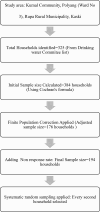Women wash practices and household diarrhea among rural indigenous Kumal community of Nepal: a cross-sectional study
- PMID: 40394572
- PMCID: PMC12090698
- DOI: 10.1186/s12889-025-23106-3
Women wash practices and household diarrhea among rural indigenous Kumal community of Nepal: a cross-sectional study
Abstract
Introduction: Access to safe water, sanitation, and hygiene (WASH) is crucial for public health. However, women and marginalized communities in Nepal continue to face significant barriers. The Kumal community, a marginalized indigenous group traditionally known for pottery, experiences a disproportionate burden of preventable diseases like diarrhea. Due to geographical isolation, cultural practices, and limited resources, women have greater health, social, and economic impacts from inadequate water, sanitation, and hygiene services. Therefore, this study aims to assess WASH practices among women and explore factors associated with household diarrhea in the indigenous Kumal community of Nepal.
Methods: A community-based cross-sectional study was conducted from October 2022 to February 2023 among women aged 18 years and older who are mostly involved in WASH-related practices in the Kumal community of Rupa Rural Municipality, Nepal. A total of 194 Kumal households were systematically selected using a sampling frame of 325 households. Data was collected through interviews using a semi-structured questionnaire adapted from the WHO/UNICEF Joint Monitoring Program (JMP). Chi-square tests and logistic regression were performed to assess the associations between WASH practices and diarrhea prevalence, with a significance threshold set at p-value < 0.05 and 95% confidence intervals.
Results: One-third of the participants reported at least one household member experiencing diarrhea in the past three months. Among children under 5 years, the prevalence of diarrhea was 41.7%. While 72.2% reported knowledge about preventive measures, only 1.5% knew the treatment of complications. Respondents with a monthly income of less than 15,000 NPR (AOR = 2.98, 95% CI: 1.42-6.23) and those who kept pigs as livestock (AOR = 4.44, 95% CI: 2.01-9.79) were significantly more likely to experience diarrhea than their respective counterparts. Those who washed their hands five times or less daily had a higher likelihood of experiencing diarrhea (AOR = 4.62, 95% CI: 1.96-10.87).
Conclusion: This study underscores the importance of WASH practices in preventing diarrhea in the Kumal community. It is crucial to address key factors like low income, livestock presence, and inadequate handwashing through targeted interventions to reduce diarrhea incidence and ultimately protect vulnerable populations.
Keywords: Children; Diarrhea; Kumal community; WASH.
© 2025. The Author(s).
Conflict of interest statement
Declarations. Ethics approval and consent to participate: Ethical approval for the study was granted by the Institutional Review Committee of Manmohan Memorial Institute of Health Sciences, Institute of Medicine, Tribhuvan University (01/09/2023- MMIHS IRC 892; Ref 79/156). The permission for the study was also taken from the Office of Municipal Office, Rupa Rural Municipality. Witten informed consent was obtained from the participants. The anonymity and confidentiality of the information were assured, and the privacy of each respondent was maintained throughout the data collection process. All procedures were conducted in compliance with the Helsinki Declaration. Consent for publication: Not applicable. Competing interests: The authors declare no competing interests.
Figures
Similar articles
-
Water, sanitation, and hygiene service inequalities and their associated factors among urban slums and rural communities in Eastern Ethiopia.Front Public Health. 2024 Nov 13;12:1438748. doi: 10.3389/fpubh.2024.1438748. eCollection 2024. Front Public Health. 2024. PMID: 39606064 Free PMC article.
-
The effect of a health extension program on improving water, sanitation, and hygiene practices in rural Ethiopia.BMC Health Serv Res. 2023 Aug 7;23(1):836. doi: 10.1186/s12913-023-09833-6. BMC Health Serv Res. 2023. PMID: 37550670 Free PMC article.
-
Lot quality assurance sampling survey for water, sanitation and hygiene monitoring and evidence-based advocacy in Bentiu IDP camp, South Sudan.PLoS One. 2024 Jul 15;19(7):e0302712. doi: 10.1371/journal.pone.0302712. eCollection 2024. PLoS One. 2024. PMID: 39008515 Free PMC article.
-
Oral hygiene practices and associated factors among rural communities in northwest Ethiopia.BMC Oral Health. 2024 Mar 9;24(1):315. doi: 10.1186/s12903-024-04049-4. BMC Oral Health. 2024. PMID: 38461252 Free PMC article. Review.
-
Outcome evaluation of WASH intervention in rural households at Jawi district, Northwest Ethiopia: Mixed method design, goal based evaluation.Eval Program Plann. 2023 Jun;98:102283. doi: 10.1016/j.evalprogplan.2023.102283. Epub 2023 Apr 7. Eval Program Plann. 2023. PMID: 37084492 Review.
References
-
- Progress on household drinking. water, sanitation and hygiene, 2000–2020: Five years into the SDGs - UNICEF DATA [Internet]. [cited 2022 Aug 14]. Available from: https://data.unicef.org/resources/progress-on-household-drinking-water-s...
-
- WHO. Diarrhoeal disease [Internet]. 2017 [cited 2022 Aug 23]. Available from: https://www.who.int/news-room/fact-sheets/detail/diarrhoeal-disease
-
- Curtis V, Cairncross S. Effect of washing hands with soap on diarrhoea risk in the community: a systematic review. Lancet Infect Dis. 2003;3(5):275–81. - PubMed
-
- Glass R. Book review: disease control priorities in developing countries. N Engl J Med. 2006;355(10):1074–5.
MeSH terms
LinkOut - more resources
Full Text Sources
Medical
Miscellaneous




